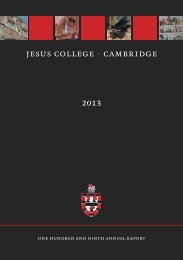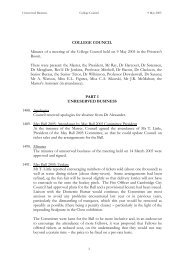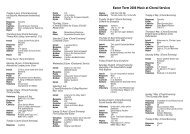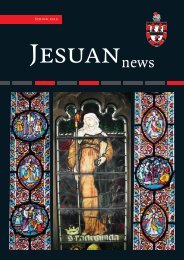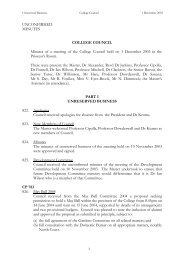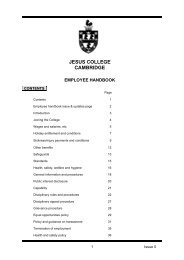2012 Annual Report - Jesus College - University of Cambridge
2012 Annual Report - Jesus College - University of Cambridge
2012 Annual Report - Jesus College - University of Cambridge
You also want an ePaper? Increase the reach of your titles
YUMPU automatically turns print PDFs into web optimized ePapers that Google loves.
A Taste <strong>of</strong> Cold Steel<br />
Lucy Fielding, <strong>Jesus</strong> Graduate Student<br />
According to archaeologists, the Iron Age began in 1300 BC and lasted for around two<br />
millennia. Today, steels (alloys <strong>of</strong> iron and carbon) comprise 95% <strong>of</strong> global metal<br />
consumption and this trend shows no sign <strong>of</strong> declining. Glancing at the media, however,<br />
one would be forgiven for assuming that steel is now a has-been. We are bombarded with<br />
stories <strong>of</strong> novel materials: carbon nanotubes, metallic glasses, graphene, carbon fibre,<br />
nickel superalloys . . . all <strong>of</strong> which are “stronger than steel”. “Now we can construct space<br />
elevators!” claim the articles. “Let’s build a climbing frame to the moon! We’ll use this<br />
stuff to make everything!”<br />
The observant among us, however, will note that most cars, trains and buildings still<br />
don’t feature superalloys, metallic glass or magic nanotubes. Neither are they invisible;<br />
nor do they fly; nor do they do any <strong>of</strong> the other things that journalists tend to ‘predict’.<br />
Instead, steels somehow remain the best – and cheapest – materials for the job. Also, they<br />
are stronger than steel. This is because ‘steel’ is a vague construct used by sensationalists,<br />
with an unspecified strength guaranteed to be less than that <strong>of</strong> a novel material.<br />
Metallurgists rarely refer to ‘steel’, just as the Inuit have fifty words for snow, not one <strong>of</strong><br />
which is ‘snow’.<br />
Steels, on the other hand, are alloys with a colourful variety <strong>of</strong> properties: strength,<br />
toughness, hardness, ductility and wear resistance. They are everywhere: railways,<br />
pipelines, bearings, jet engines, armour, nuclear reactors . . . and more. Many <strong>of</strong> these<br />
technologies are cutting-edge in their design, and require highperformance steels to<br />
match. The benefits <strong>of</strong> steels lie first and foremost in their versatility. Iron atoms can ‘stack’<br />
themselves in various distinct configurations (just like a greengrocer stacking oranges –<br />
there are different ways to do it). Each configuration is known as a ‘phase’. As well as the<br />
two main iron phases (austenite and ferrite) there is a carbide phase – a compound <strong>of</strong> iron<br />
and carbon (Fe3C) – called cementite. These phases <strong>of</strong>ten exist in combinations and have<br />
different properties. For example: cementite is strong and brittle, whereas ferrite is s<strong>of</strong>ter<br />
and tougher. If we combine them into a structure called pearlite (consisting <strong>of</strong> alternating<br />
layers <strong>of</strong> ferrite and cementite), we produce a steel that is reasonably strong and tough.<br />
Transmission electron microscope<br />
image <strong>of</strong> superbainite structure.<br />
α = ferrite and γ = austenite.<br />
The inset image is a carbon<br />
nanotube to scale<br />
METALLURGY I <strong>Jesus</strong> <strong>College</strong> <strong>Annual</strong> <strong>Report</strong> <strong>2012</strong> 29





